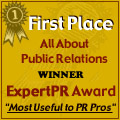|
by
Tony Panaccio
EMSI
Public Relations
 Maybe
it’s me, but I read something the other day that made me wonder
if I’m the only one who doesn’t see the logic here. Maybe
it’s me, but I read something the other day that made me wonder
if I’m the only one who doesn’t see the logic here.
The Nielsen Company tracks the audience viewership of TV
programs so that programmers and advertisers can get a handle on
how many people are watching certain shows. Programmers take
that data and figure out how much they’ll charge to advertise on
their shows.
Of course, they pay attention to key
demographics and more granular statistics, but at the end of the
day, this is the data that helps them figure out that they’re
going to charge $3 million per minute to advertise on The Super
Bowl broadcast and $1 - $3.80 per minute on reruns of the recent
reboot of Hawaii Five-0.
I think I’ve got that right, but now Nielsen is tracking ratings
for shows people record and watch on their DVRs later. They even
have it segmented to track people who watch shows on the same
day they record it and up to 7 days afterward. I just have one
question, and forgive me if I seem obtuse here, “Why?”
Most people fast-forward through the commercials when they watch
their favorite show on their DVR. I know I do. Even Nielsen
acknowledges the phenomenon. They reported in 2010 that of the
33 percent of Americans that own a DVR, 56 percent fast-forward
through commercials. Of course, this was not a survey of general
Americans, but rather of Nielsen families who are accustomed to
keeping an electronic diary of their viewing. So maybe they’re
on slightly better behavior than the rest of us.
The key thing I’m wondering about is how much longer does the TV
commercial have as an advertising tool? The trend is clear that
the DVR is becoming more common and that people are typically
using it to avoid the constant barrage of advertising they are
subjected to every day.
Billboards on the highway,
commercials on the radio, banners and pop ups on the Internet,
people are simply tired of the constant assault of advertising
on their senses. So they use the DVR, they switch stations on
the car radio when the commercials come on and many even choose
more scenic routes for their morning commutes.
The upshot is this, as people reject advertising more and more,
what happens between the commercials becomes more important.
That’s why PR is still the best value for the money, because no
matter what technology people come up with to block or ignore
advertisements, they only do so because they are far more
interested in what is happening on the shows they watch and
listen to, and the publications they read online and offline.
Moreover, advertisements lack any
kind of third-party verification, and consumers have become so
media savvy, they know the difference between an ad and a show.
They know advertisers pay big money for those spots on The Super
Bowl and on their favorite shows, and they understand that they
control their messages. They also know, and generally trust, the
editorial side of the media. That’s what they read online, what
they listen to on radio and what they tune into when they watch
TV.
You can’t buy that kind of trust with an ad and the only way you
can get on the air or in editorial print coverage is through PR.
So don’t mourn for the TV commercial just yet. But feel free to
wave as you pass it by on your way to your TV interview.
Tony Panaccio is Senior Campaign Manager for
EMSI
Public Relations,
a national firm providing PR strategy and publicity services
to corporations, entertainers and authors.
More Articles |
Submit Your Article |
PR Subjects
About Public Relations Homepage
Contact Us
|



